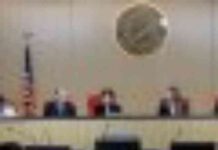(Washington) The US Federal Reserve on Wednesday raised its main interest rate for the tenth time in a row since March 2022, by a quarter of a percentage point, determined to curb inflation despite signs of a slowing economy. and despite the recent banking crisis. However, the tone of the institution has changed. Overview.
The Fed’s main policy rate is now in a range of 5% to 5.25%, the highest since 2006, a unanimous decision, the institution said in a statement after the meeting. meeting of its monetary policy committee (FOMC).
Many market players are now waiting for a break in these rate hikes, which increase the cost of credit for households and businesses, and, by slowing down economic activity, should make it possible to ease the pressure on prices.
Although a pause in the hikes was not formally considered at this meeting, Fed Chairman Jerome Powell pointed out that the language of the statement had changed in tone. The Fed no longer indicates that it anticipates additional hikes: “We took that part out. This is a significant change,” Powell said.
Fed officials say they will watch the effects of successive decisions and the time with which they take effect on the real economy, as well as “economic and financial developments”, in deciding whether to tighten further, to bring inflation down to 2%, its target.
The Fed chief judged that the Fed’s monetary policy is now “restrictive”, meaning that it prevents economic activity from continuing to overheat.
However, “no decision on a break was made today,” he warned. Support for a quarter-percentage-point hike “was very strong in the committee,” he noted, “people talked about a break, but not so much for this meeting.”
And no rate cuts are on the cards before the end of the year because inflation “is not going to come down quickly,” Powell said.
Convera Financial Services analyst Joe Manimbo said, “The Fed’s statement gives policymakers complete flexibility to suspend rate hikes or continue with others, depending on inflation developments and the risks facing the Fed.” economy has to deal with, such as the continued instability of some regional banks”.
The banking crisis provided unexpected support for the Fed’s fight against inflation: “Tighter credit conditions for households and businesses are likely to weigh on economic activity, hiring and inflation” , warns the Fed in its statement, hammering that “the American banking system is strong and resilient”.
And, while still resisting, the American economy multiplies the signs of shortness of breath, long awaited and finally visible.
First-quarter growth was 0.3% from the last three months of 2022 and just 1.1% annualized. And the likelihood of a recession is widely priced in by the markets.
The fragility of certain banking establishments has returned to the fore with the fall of the regional bank First Republic, finally acquired over the weekend by JPMorgan Chase, number one in the sector.
Concern about the strength of these mid-sized banks remains strong, with several of them still falling slightly on Wall Street after falling sharply the day before.
While price trends fell sharply in March, core inflation (excluding food and energy prices) barely slowed and is now higher than inflation itself.
Jerome Powell has been saying for months that bringing US inflation back to its 2% target will be a long and difficult effort, but a necessary one, because sustained inflation would have even more detrimental consequences for the economy, according to him.




